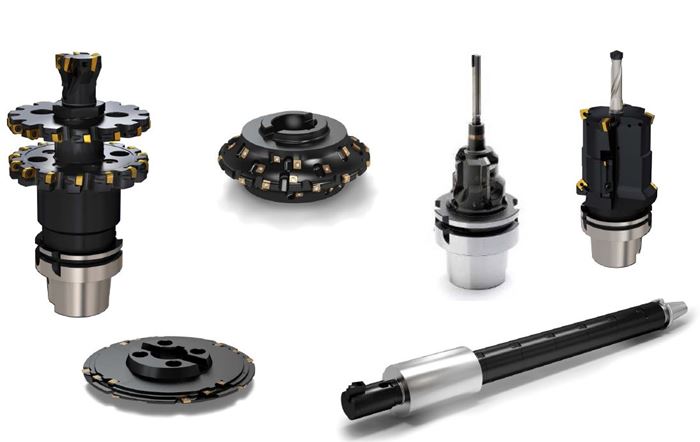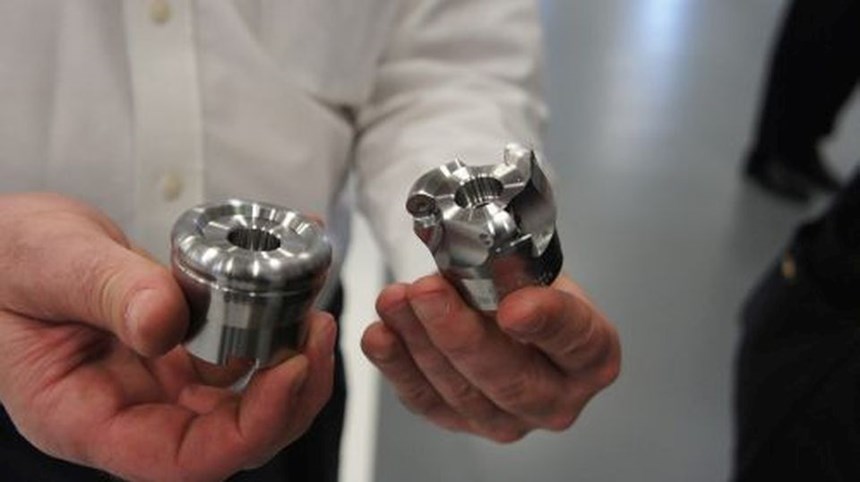Thinking Beyond the Tool Catalog Helps Everyone Succeed
In an era when many are doing more with less, both cutting tool suppliers and the manufacturers they serve have plenty to gain from deeper collaboration.
Share





Vickers Engineering appreciates the value proposition of quality cutting tools. Given a niche in mostly high-volume automotive parts, the 140-employee New Troy, Michigan manufacturer particularly appreciates the value proposition of cutters that have been custom-engineered for specific applications. In this company’s view, “special” is anything but a dirty word.
Consider a recent case in which a long-standing customer suddenly boosted part volume on a repeating brake plate order from 24,000 sets to 193,000 sets of plates. “We threw virtually every cutting tool in the plant at this job to get the parts out the door, and we made it, but the cost per piece doubled,” recalls Jeff Vickers, vice president of engineering and sales. Now, thanks in part to custom-engineered rough boring/chamfering tooling, the job is far more rewarding. Cycle times and costs have dropped from 390 seconds and 73 cents per pair of parts to 315 seconds and 29 cents per pair, resulting in a monthly cost savings exceeding $10,000, Mr. Vickers says. Quality has improved, too, judging from a Cpk improvement from 0.9 to greater than 3 on all critical dimensions. The extra cost associated with the custom tooling paled in comparison to these gains, and the process is now more efficient than it was before the volume increase (318 seconds per spindle and 42 cents per pair of parts). “We live in a world of seconds and cents, and every one counts,” Mr. Vickers says.
Mr. Vickers relayed this story to Modern Machine Shop and other leading trade publications during a recent press event hosted by Seco Tools. It was just one of many real-world examples highlighted at the event, and all drove home the same point: custom-engineered or not, tool costs typically constitute such a small percentage of overall production costs that even slight improvements in productivity and/or tool life can more than make up the difference.
The folly of focusing on tool cost alone wasn’t the press event’s only takeaway. Here are a few others:
Manufacturers need more than just tools. The very fact that Seco hosted this press event shows that custom tools—and, more broadly, value-added consulting services—are a top priority, and for good reason. Stories like the one told by Vickers Engineering demonstrate that manufacturers have plenty to gain from deep collaboration on process development. The fact that many customers’ engineering departments are generally doing more with less compared to recent years only amplifies the need, says Ken Bellinger, manager of the company’s Component Engineered Tooling (CET) program.
Meanwhile, trends driving manufacturers into unfamiliar territory are making competitive pressures more intense in usual-suspect sectors for custom tooling and process development consultation. Consider Aerospace. Rather than being machined in-house by large suppliers like Airbus or Boeing, small, difficult-to-machine parts like casings, blisks and composite structures are increasingly relegated to smaller subcontractors without the same engineering resources, says Scott Causey, aerospace and power generation market segment specialist. Meanwhile, to reduce vehicle weight and improve fuel efficiency, automotive industry players are increasingly working with relatively unfamiliar, lighter materials like aluminum and compacted graphite iron as well as new part designs, Mr. Bellinger adds.
Yet, even shops that have never considered custom-engineered tooling—even including smaller contract manufacturers with a high mix of low-volume work—stand to gain from the company’s knowledge. After all...
All tooling is custom, at least in a certain sense. That is, even standard tools are designed for specific materials and conditions. And even without considering a truly custom-engineered solution or even a minor adjustment like an altered rake angle, choosing the right tool for the job takes expertise. Perhaps even more important is guidance on how best to use a given tool in concert with the technology at a specific manufacturer’s disposal.
Tool suppliers are likely to be eager, earnest partners. Cutting tool suppliers aren’t the only source of knowledge. Manufacturers can certainly benefit from the process development expertise of machine tool builders, CAD/CAM software developers and other technology suppliers as well. Indeed, it’s commonplace for such companies to also be involved in Seco’s consultations with customers. However, various discussions at the press event evidenced a belief that helping manufacturers think beyond the tool catalog is just as important for Seco’s own competitiveness as for that of its customers.
This incentive isn’t immediately obvious. After all, Seco doesn’t receive a dime for its expertise, at least not directly. When consultations do lead to sales, holders and cutter bodies aren’t the primary source of profit either, says Bob Goulding, manager, technical engineering. That distinction goes to the carbide. Somewhat ironically, the very goal of a cutting tool company—to make edges perform better and last longer—serves only to reduce demand for carbide. Thus, competitiveness requires more than just innovative products. It requires ensuring customers keep coming back for those products. In Seco’s view, one of the best ways to do that is to differentiate itself through a reputation for helping manufacturers solve problems and develop processes, Mr. Goulding says. During the past few years, the company’s efforts reflect a focus on doing just that.
Relationships need work. That truism isn’t lost on Seco, at least judging from the company’s activities during the past few years. In 2013, the company’s Custom Tooling division moved from its original location in Tennessee to the Troy, Michigan North American headquarters facility where the press event was hosted. Although capacity was a concern at the time, this move also had another goal: to more closely integrate custom tool manufacturing with engineering and design, Mr. Goulding says.
Such synergy is critical to the company’s aim of acting essentially as an extension of manufacturers’ own engineering departments. The deepest level of collaboration is provided through its Component Engineered Tooling (CET) service. Leveraging the knowledge of 11 other facilities around the globe as well as various other supplier partners, CET develops full turn-key manufacturing processes, complete with cycle time and cost breakdowns, that account for everything from the workholding to the machine to the toolpath strategy. With designers working alongside engineers, and with global connectedness to other facilities that can keep working while North America sleeps, the company considers this division better equipped than ever before to deliver solutions quickly.
Of course, delivering solutions quickly requires manufacturing as well as design efficiency, and the company reports that the Custom Tool Division has come a long way since starting essentially from scratch at the new location a little more than two years ago. Since then, typical lead times for non-emergency, custom orders have dropped from 8 working weeks to a little more than 6 working weeks, and the company aims to reduce that figure to 5 weeks by the end of this year. Gains can be attributed to sophisticated equipment, such as five-axis machining centers with robotic automation that help minimize material handling, as well as strategy. For instance, the company has abandoned the common practice of rough, heat treat and finish, opting instead to machine all components in the hardened state. Culture comes into play as well. Having key metrics displayed on flatscreens visible to everyone reportedly helps staffers stay on track and motivates them to take the initiative in identifying and remedying any inefficiencies, Mr. Goulding says.
Expertise isn’t the only value-add. Custom engineered tooling and process consulting aren’t the only examples of the company thinking beyond the tool itself. For instance, the Seco Material Group (SMG) classification system, which offers cutting data for specific tool-material combinations, has been simplified and expanded to include narrower ranges of recommended parameters. “My Pages” provides a digital portal to everything Seco, including product information, order tracking, CNC code generation, and suggested cutting strategies. The Seco Technical Education Program (STEP) is designed to offer supplier-independent technical education for users at all levels of expertise.
All in all, in an era where innovative product might not be enough by itself, the company is banking on value-added services to provide a competitive edge. In the abstract, that’s a message any manufacturer can take to heart.
Related Content
The Future of High Feed Milling in Modern Manufacturing
Achieve higher metal removal rates and enhanced predictability with ISCAR’s advanced high-feed milling tools — optimized for today’s competitive global market.
Read MoreQuick-Change Tool Heads Reduce Setup on Swiss-Type Turning Centers
This new quick-change tooling system enables shops to get more production from their Swiss turning centers through reduced tool setup time and matches the performance of a solid tool.
Read MoreShoulder Milling Cuts Racing Part's Cycle Time By Over 50%
Pairing a shoulder mill with a five-axis machine has cut costs and cycle times for one of TTI Machine’s parts, enabling it to support a niche racing community.
Read MoreToolpath Improves Chip Management for Swiss-Type Lathes
This simple change to a Swiss-type turning machine’s toolpath can dramatically improve its ability to manage chips.
Read MoreRead Next
5 Rules of Thumb for Buying CNC Machine Tools
Use these tips to carefully plan your machine tool purchases and to avoid regretting your decision later.
Read MoreSetting Up the Building Blocks for a Digital Factory
Woodward Inc. spent over a year developing an API to connect machines to its digital factory. Caron Engineering’s MiConnect has cut most of this process while also granting the shop greater access to machine information.
Read MoreBuilding Out a Foundation for Student Machinists
Autodesk and Haas have teamed up to produce an introductory course for students that covers the basics of CAD, CAM and CNC while providing them with a portfolio part.
Read More





















.png;maxWidth=300;quality=90)











